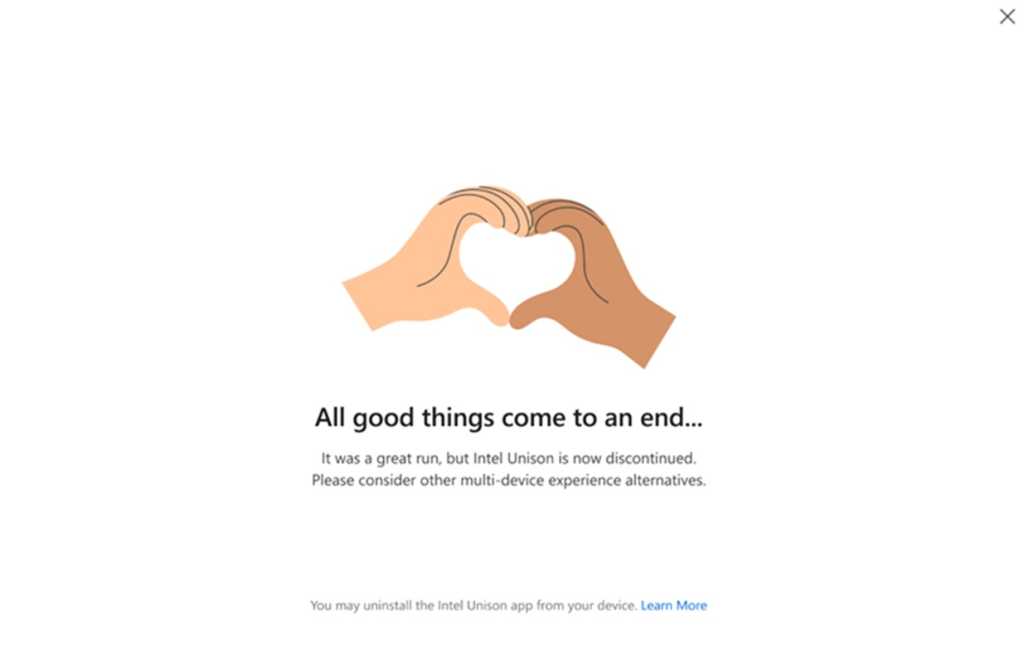In a significant setback for cross-device connectivity, Intel has announced that its Unison application is set to be officially discontinued. This ambitious project aimed to synergize the functionality of laptops and smartphones into a single user-friendly platform, giving users seamless access to their devices. However, unless you own a select few Lenovo PCs, the Unison app will no longer be available for use after June 30, 2025.
The Unraveling of Intel Unison
Intel’s Unison program was designed to enhance the connectivity between PCs and mobile devices. It allowed users to receive notifications, manage messages, and access apps directly from their laptops—a feature that many consumers were eager to utilize. Unfortunately, recent developments indicate that this program has not been successful in achieving widespread adoption. Intel’s official Unison page highlights that the app “will soon be discontinued,” as confirmed in a related Intel Knowledge Base article. Dell has echoed this sentiment with a statement asserting that the app will not function beyond its discontinuation date.
Intel’s rationale for terminating Unison seems to stem from a broader effort to cut costs due to an economic downturn, which has also led to significant layoffs within the company. These challenging circumstances have prompted Intel to reevaluate its product offerings, as seen with internal shifts in manufacturing processes, including the scaling-back of its next-generation 18A technology to be reserved for internal usage only.
Market Landscape for Device Connectivity
For a while, the tech landscape was rife with applications aimed at bridging the gap between mobile and desktop experiences. Dell’s Mobile Connect, which has managed to remain operational, was one alternative that competed with Intel Unison. While Intel initially envisioned the Unison application as a versatile platform for cross-device connectivity, Microsoft introduced the Windows Your Phone app, later rebranded as Phone Link. Despite Unison’s promising feature set—offering better connectivity with Apple iPhones compared to Phone Link—Microsoft’s offering continued to expand, supporting all Windows PCs regardless of the processor manufacturer.
Phone Link has further evolved to enable management of iPhone messages and calls, and it is now integrated into the Windows Start menu, showcasing a solid path to deeper system integration that Intel’s Unison could not replicate. The seamless accessibility of Phone Link likely contributed to the consumer preference for Microsoft’s solution over Intel’s application.
Lenovo’s Special Exception
Interestingly, Lenovo has become an outlier in this narrative. According to Intel, Lenovo Aura PCs will continue to support the Unison application through the end of the year. This includes several models such as the ThinkPad X1 Carbon Gen 13 and the Yoga Slim 7 series. The decision to sustain Unison’s functionality on these devices might reflect Lenovo’s commitment to providing enhanced connectivity options for its users, ensuring that a niche segment of the market can still benefit from what Unison aimed to achieve.
Implications for Future Innovations
The discontinuation of Intel Unison raises broader questions about the future of cross-device connectivity initiatives. As technology firms streamline their focus toward what remains effective and profitable, the landscape for facilitating seamless device integration will likely continue to evolve. The competition among platforms will likely escalate, possibly leading to more robust solutions that prioritize user experience and accessibility.
According to a report by Statista, global smartphone penetration reached 78% in 2023, which highlights the increasing need for effective cross-device solutions. Companies must recognize that consumer demand is shifting towards features that enhance productivity and connectivity, suggesting that future solutions may require more than just app-centric approaches.
As the tech industry navigates its way through challenges in productivity and efficiency, the lesson from Intel Unison’s closure is clear: creating a successful cross-device experience requires ongoing support, innovation, and alignment with user needs. The need for a cohesive, interconnected digital ecosystem remains, and manufacturers must capitalize on this demand to stay competitive.

